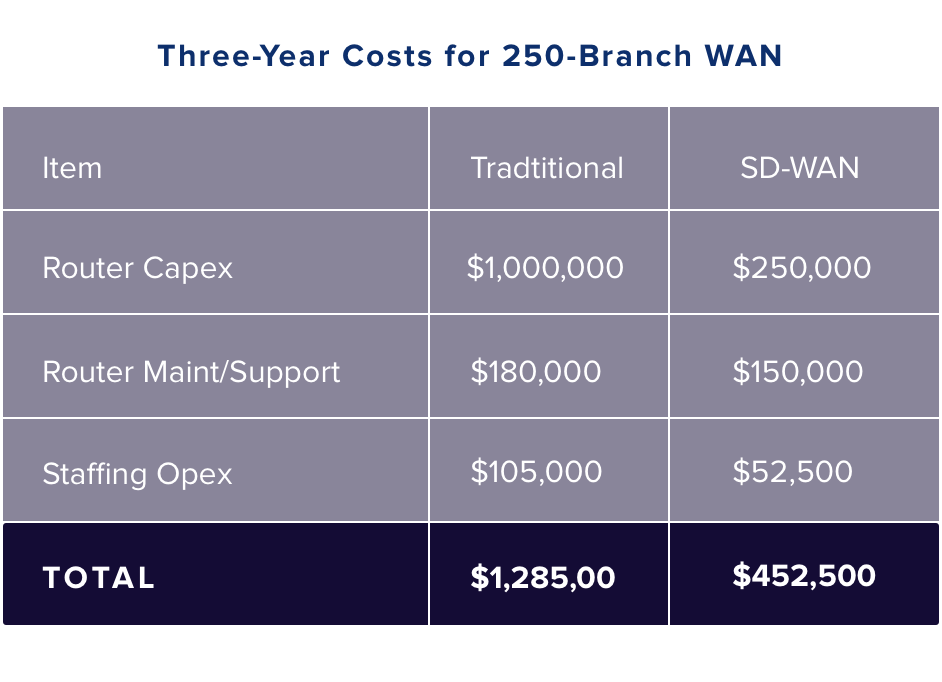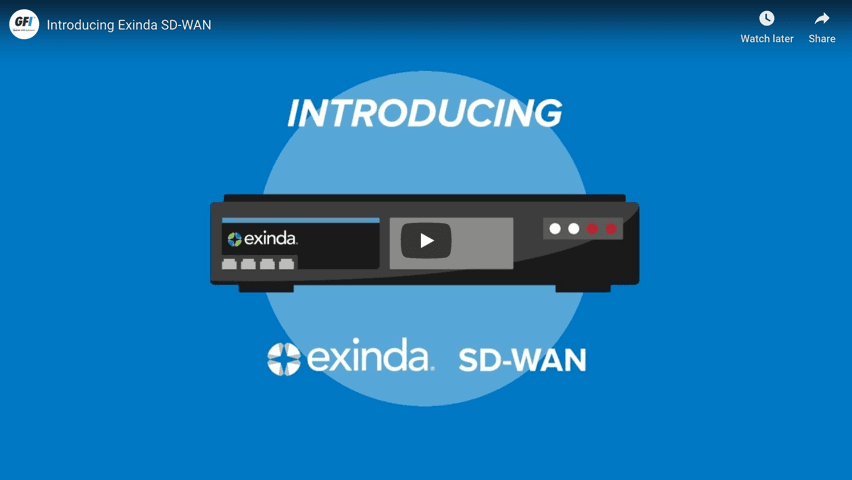What is SD-WAN and how does it work?
Software defined wide area network (SD-WAN) is a type of computer network that enables bonding of multiple internet access resources – such as DSL, cable, cellular or any other IP transport – to provide reliable high throughput data channels. SD-WAN abstracts connectivity options – like multiprotocol label switching (MPLS), mobile and broadband – to create a virtual enterprise wide-area network (WAN).
An SD-WAN has a virtual WAN architecture and a software-driven technology. A key element of an SD-WAN is its centralized control, so that network connections, security mechanisms, policies, application flows and general administration are separated from the associated hardware.
One can think of SD-WAN as series of encrypted tunnels across underlying services that provides application routing and optimized path selection, so packets end up

in the correct tunnel. Then from the tunnel, underlying data services determines the path to the destination. SD-WAN’s architecture enables a high-speed IP communication framework between a branch office and headquarters – as well as among branch offices – even over large geographic areas.
Why should businesses use SD-WAN?
Companies are rapidly adopting software defined wide area network technology because of its many operational and financial benefits. In fact, the International Data Corporation (IDC) predicts that the SD-WAN infrastructure market will grow at a 40.4 percent compound annual growth rate, reaching $4.5 billion by 2022. [1]
SD-WANs can solve a major business problem of ensuring reliable internet connectivity. Without robust connectivity, a business may face disruptions caused by link failures, network latency or WAN blackouts. These disruptions can be costly. Gartner estimates[2] network downtime may cost up to $5,600 per minute, or more than $300,000 per hour.
SD-WAN can help businesses – especially small-to-medium-size businesses have cost-efficient, secure, cloud-based WAN connectivity without worrying about unplanned budget spend. SD-WAN combines traditional physical networking with software-based virtual functionality. A business can make changes to the entire network at one time, effortlessly.

One of the biggest advantages of SD-WAN is controlling the policy environment more easily than before. Businesses can customize network characteristics as SD-WAN can manage multiple types of connections. SD-WAN allows for critical network applications and gives a secondary priority to high-consuming bandwidth traffic like video streaming or social media.
SD-WAN can ensure your business data flows, without interruption, by powering up the weakest link of the network and making sure it’s strong enough to support the usage. Other business benefits to using SD-WAN include:
-
Lower networking costs
By effectively supporting multiple connection types like MPLS, Ethernet and Wi-Fi, a company can choose the one that makes the most sense. -
Eliminate network outages
SD-WAN lets a business automatically route traffic based on the office location and other criteria, so the network remains always available. If one office is out of internet connection, SD-WAN will reroute network traffic from another available locations automatically, with zero downtime. -
Higher employee productivity and focus
SD-WAN gets employees online quickly and allows them to easily access the most-used business applications. SD-WAN also has intelligent routing, so that each employee gets the best application performance and a great user experience. -
Reduce labor costs
SD-WAN reduces the need to pay dedicated IT personnel to monitor the network access constantly in order to detect outages and manually switching WAN access. -
Avoid on-site installation and management
SD-WAN does the installation itself. A company sends the virtualization appliance to the branch office that needs to connect to the network and IT simply plugs it in. Being preconfigured, the branch is now connected, using a single management application.
When SD-WAN implementation makes sense
A recent Gartner research report[3] identified the types of businesses most likely to benefit from implementing SD-WAN into their IT infrastructure.
If a business is looking to move a large number of applications to the public cloud, such as Office 365 or Google G, SD-WAN implementation makes a lot of sense. This is also true if an organization wants to create hybrid WAN topology by deploying internet access directly from its branch locations.
Companies will greatly benefit by transitioning to SD-WAN if they are wanting to:
-
Service more than 25 remote branches
-
Eliminate or greatly decrease on-site IT personnel from remote branches
-
Reduce the cost of conventional business-class carrier service
-
Decrease WAN management complexity
-
Deploy bandwidth-intensive and/or real-time applications to its branch offices
Use Cases: Businesses implement SD-WAN
Recent Network World articles[4-7] have featured a number of businesses – large and small – who have recently adopted the SD-WAN network model. Here are some highlights from these companies’ experiences:
-
Financial
Entegra Bank of North Carolina switched to SD-WAN broadband from MPLS links for its 22 branches. The institution decreased the cost of WAN connectivity by 50 percent and increased bandwidth roughly fivefold. -
Specialty grocer
Northgate Gonzalez has deployed SD-WAN in its 40 specialty grocery stores in Southern California. The deployment has increased bandwidth because connections are used interchangeably through SD-WAN. Monthly connectivity expenses were reduced by up to 40 percent. SD-WAN prioritizes traffic for the grocer’s key business functions such as payments and ordering. And with the almost zero-touch appliance provisioning, installing appliances are easy. Store technicians and help desk members can get the preconfigured appliances quickly functional at each site. -
Scientific equipment manufacturer
National Instruments is a US-based manufacturer of scientific equipment and software. Because it operates with 8,400 employees in 50 countries, it turned to SD-WAN to handle it complex distributed workflow. Because of SD-WAN’s zero-touch provisioning the firm saves money by not having to send engineers to all its world-wide offices. -
Pharmaceutical packing manufacturer
Gerresheimer AG manufactures packaging products for medication and drug delivery devices and has 43 sites in more than 15 countries. Its transition to SD-WAN has saved Gerresheimer $10,000 a month and its MPLS has tripled in speed. The savings resulted from the company now having the leverage to negotiate MPLS contracts for higher speeds for at a reduced cost. -
Healthcare clinics
Zwanger-Pesiri has 24 outpatient radiology clinics in the New York City area. The company requires a terabyte of imaging records per day and access to more than 1.2 petabytes of patient data. With SD-WAN, the medical firm now gets redundant 500Mbps broadband connections at each branch, with service contracts that guarantee bandwidth for less than what it formerly paid for single 100Mbps MPLS links. SD-WAN also makes setting up new offices much easier. Technicians can now configure a new office and connect the equipment to the SD-WAN wirelessly through LTE cards. -
Training and Development
City & Guilds Group performs training and skills development in more than 100 countries. Office 365 would not run reliably over its legacy network and so the company transitioned to SD-WAN. The new deployment tripled application performance which significantly improved worker productivity.
Using SD-WAN software for better network management
In spite of all the advantages, SD-WAN control and management across multiple locations can still be a significant challenge for businesses with IT resource limitations. Many organizations are turning to third-party SD-WAN providers for SD-WAN management software solutions. One example is the Exinda SD-WAN software from SD-WAN vendor, GFI Software.
With Exinda SD-WAN, you can combine and manage up to twelve internet connections into a single, ultra-high-speed line through a bonding tunnel. With the overlay tunnel technology of Exinda SD-WAN, the application flows can be kept alive even during WAN blackouts or brownouts, providing seamless session continuity.
Exinda SD-WAN means it is not necessary to have an IT team monitoring your network 24×7 to ensure network access continuity. Exinda SD-WAN does it automatically. If primary access fails, traffic is automatically routed through the remaining WAN links.
Exinda features include:
-
High-speed connectivity from branches to the headquarters/datacenter
-
High-speed general internet access at the branch office
-
Up to 75 percent cost reduction on monthly internet access fees and a faster return on investment
-
Plug-and-play transparent installation and an advanced SD-WAN router gateway
Another feature is Exinda’s intelligent WAN automation. The overlay tunnels leverage advanced algorithms to monitor, remember, learn and react to a business’ network traffic in real-time and on the packet level. Services such as live video, VOIP, chat applications, file transfers or any other types of specific application flows are mapped onto corresponding overlay tunnels.
Blogs

Are you ready to power up your business network?
Discover how SD-WAN lets you easily connect geographically dispersed offices and save costs.

You Say WAN Acceleration, I Say WAN Optimization
Ensure that your IT environment is adaptable to your business needs instead of trying to reverse engineer the business needs to fit your technology.

What’s the difference between WAN optimization and WAN acceleration?
Learn about WAN optimization and what you can do to make the most out of your bandwidth.

Optimization is Everywhere… But is it on your WAN?
Discover why optimization is really about intelligent coordination.

Introducing Exinda SD-WAN
Watch this short video to see how SD-WAN technology can help you achieve exceptional application performance on your network.
Webinar: Discover the business benefits of SD-WAN solutions
Watch this on-demand webinar to discover how you can use Exinda SD-WAN to easily connect central and branch offices and more.
Footnotes
-
SD-WAN Infrastructure Market Poised to Reach $4.5 Billion in 2022, According to IDC. Press release August 7, 2018.
-
The Cost of Downtime. Andrew Lerner. Blog. July 16, 2014.
-
Technology Insight for SD-WAN. Andrew Lerner, Jonathan Forest, Neil Rickard and Ted Corbett. Gartner Report. September 14, 2018.
-
How to make the business case for SD-WAN. Neal Weinberg. Network World. November 7, 2018.
-
SD-WAN: The inside scoop from real-world deployments. Sandra Gittlen. Network World. October 30, 2018.
-
How SD-WAN saves $1.2M over 5 years for a radiology firm. Marc Ferranti. Network World. February 21, 2018.
-
City & Guilds Group deploys SD-WAN to improve Office 365 performance. Zeus Kerravala. Network World. April 18, 2018.
Related Posts

Jun 18, 2024
GFI Software announces its Headline Sponsorship of the Managed Services Summit Benelux in Amsterdam
GFI AppManager and AI take center stage as GFI Software leads the conversation on how these technologies are shaping the future of the MSP industry.

May 2, 2024
Webinar: Cybersecurity in the age of distractions
Workplace distractions can lead to severe cybersecurity risks. In this webinar, our experts reveal the hidden dangers and provide actionable insights to fortify your digital safety. Discover how distractions can cause security breaches, learn from real-world examples of costly errors, and explore strategies to reinforce security using GFI's products. Gain best practices for fostering a cybersecurity-aware culture.

Apr 17, 2024
GFI Integrates AI Capabilities Into Four Core Products
GFI Software's AI-powered CoPilot Enhances Security and Network Management in GFI MailEssentials, GFI KerioControl, GFI ClearView, and GFI LanGuard

Apr 11, 2024
Outsmarting the Machines: Protecting Against AI-Powered Cyberattacks
AI is revolutionizing cybersecurity, but it's a double-edged sword. In this post, we explore the growing landscape of sophisticated, AI-powered cyber threats like morphing malware and hyper-personalized phishing scams.We also dive into how organizations can harness AI's immense potential to bolster defenses through advanced threat detection, autonomous response capabilities, and predictive vulnerability analysis.

Apr 4, 2024
New Privacy Rules - Friend or Foe? A Business Guide to Navigating Regulations
Privacy laws are evolving; businesses must adjust. Learn key rules and how GFI ensures email/network security compliance.

Mar 5, 2024
Understanding HIPAA: A Guide for Healthcare Providers and Businesses
If you're a healthcare provider or business handling protected health information, understanding HIPAA is crucial. This guide demystifies HIPAA's requirements for safeguarding patient data and outlines best practices for compliance. We'll delve into risk assessments, employee training, breach prevention, and how GFI Software can help you avoid potential penalties and protect your practice.